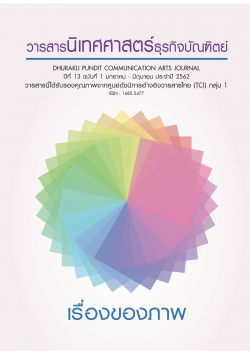ภาพตัวแทนความรักและความสัมพันธ์ของหญิงสาว ในบทเพลงของกลุ่มศิลปินหญิง: จาก สาว สาว สาว ถึง BNK48
คำสำคัญ:
ภาพตัวแทน, หญิงสาว, วัฒนธรรมหญิงสาว, เกิร์ลกรุป, เกิร์ลดูโอบทคัดย่อ
งานวิจัยชิ้นนี้มีวัตถุประสงค์เพื่อศึกษาภาพตัวแทนความรักและความสัมพันธ์ของหญิงสาวในบทเพลงของกลุ่มศิลปินหญิง โดยคัดเลือกกลุ่มศิลปินหญิง 8 วง ที่มีอิทธิพลในอุตสาหกรรมเพลงไทยในช่วงระยะเวลาตั้งแต่ปี พ.ศ. 2525-2561 โดยศึกษาตัวบท (textual analysis) ของเนื้อหาในเพลง และศึกษาบริบท (contextual analysis) ของอุตสาหกรรมเพลงในช่วงที่บทเพลงนั้นถูกผลิตขึ้นมา ผลการวิจัยคือภาพตัวแทนของความสัมพันธ์ของหญิงสาว สามารถจำแนกได้สี่แบบหลัก คือ หญิงสาวที่แอบรัก หญิงสาวที่มีแฟนหรือคนรัก หญิงสาวที่ผิดหวังในความรัก และหญิงสาวกับมิตรภาพความเป็นเพื่อน แต่ในแต่ละช่วงระยะเวลาได้มีความเปลี่ยนแปลงในเนื้อหาของเพลง เช่น หญิงสาวที่แอบรักกล้าแสดงออกมากขึ้น หญิงสาวที่มีแฟนหรือคนรักก็มีบทบาทในการเริ่มต้นความสัมพันธ์มากขึ้น รวมทั้งหญิงสาวที่ผิดหวังในความรัก ก็ไม่ได้มองว่าความผิดหวังนั้นเป็นสิ่งที่ร้ายแรง ซึ่งพัฒนาการของภาพตัวแทนเหล่านี้ มีผลจากปัจจัยทั้งอิทธิพลของวงการเพลงตภายในประเทศและต่างประเทศ ภาพลักษณ์ของวงดนตรี และอายุการทำงานในวงการของศิลปิน ซึ่งภาพตัวแทนเหล่านี้เป็นสิ่งที่สะท้อนวัฒนธรรมหญิงสาวในแต่ละยุคได้เป็นอย่างดี
เอกสารอ้างอิง
กาญจนา แก้วเทพ. (2557). ศาสตร์แห่งสื่อและวัฒนธรรมศึกษา. กรุงเทพฯ: ภาพพิมพ์
ณัฐภรณ์ สถิรกุล. (2537). กระบวนการสร้างนักร้องยอดนิยมของ บริษัท แกรมมี่ เอ็นเตอร์เทนเม้นท์ จำกัด. (วิทยานิพนธ์มหาบัณฑิต) บัณฑิตวิทยาลัย จุฬาลงกรณ์มหาวิทยาลัย.
ทับทิม ชัยชนะ, โกชัย สาริกบุตร และ รังสรรค์ จันต๊ะ. (2559). บทบาทของผู้หญิงสามัญในเพลงลูกทุ่งร่วมสมัย. พิฆเนศวร์สาร. 12(2): 53-62.
ปรมาภรณ์ ลิมป์เลิศเสถียร. (2557). เพลงนอกใจ: ทางออกของคนในสังคมไทย. วารสารวิชาการมหาวิทยาลัยหอการค้าไทย. 34(1): 211-224.
ประชาชาติธุรกิจ (2561). สาว สาว สาว เล่าความทรงจำ เกิร์ลกรุ๊ปกลุ่มแรกกับวิถีอินดี้ในยุคที่ยังไม่มีคำว่า “อินดี้”. สืบค้นจาก https://www.prachachat.net/d-life/news-220431
เหมือนฝัน มานตรี. (2556). การเผยแพร่เพลงกระแสนิยมญี่ปุ่นภายใต้กระแสโลกาภิวัตน์: กรณีศึกษาศิลปินวงเอเคบี 48. (วิทยานิพนธ์มหาบัณฑิต) คณะภาษาและการสื่อสาร สถาบันบัณฑิตพัฒนบริหารศาสตร์.
ยุคลรัตน์ เจตนธรรมจักร. (2537). กลยุทธ์ของการสร้างภาพลักษณ์นักร้องไทยสังกัดบริษัทคีตาเรคคอร์ดส จำกัดในช่วงระยะ พ.ศ. 2531-2534. (วิทยานิพนธ์มหาบัณฑิต) บัณฑิตวิทยาลัย จุฬาลงกรณ์มหาวิทยาลัย.
ยอดมนุษย์..คนธรรมดา. (2562). Dojo City ประวัติศาสตร์ 20 ปีของเจ้าของวัฒนธรรมป็อบสำคัญที่สะท้อนตัวตนวัยรุ่น Gen Y. สืบค้นจาก https://readthecloud.co/dojo-city/?fbclid=IwAR1irBOYI0auXxoF1VipsRCH1AFV2UglBXtNOcBhGzBIfLI12d5AIZ4OwG8
วิภว์ บูรพาเดชะ. (2561). ระย้าแห่ง ‘รถไฟดนตรี’ ค้นพบศิลปินที่จะกลายมาเป็นตำนานได้อย่างไร?. สืบค้นจาก https://happeningandfriends.com/article-detail/97?lang=th
ศิรินภา นรสาร. (2557). กลยุทธ์การสร้างภาพลักษณ์ศิลปินลูกทุ่งหญิงของบริษัทอาร์สยาม. (วิทยานิพนธ์มหาบัณฑิต). คณะนิเทศศาสตร์ มหาวิทยาลัยสุโขทัยธรรมาธิราช.
สุประสิทธิ์ สิทธิอารีย์. (2543). การสื่อสารการตลาดของธุรกิจเทปเพลงเพื่อการสร้างภาพลักษณ์ของศิลปินเพลง กรณีศึกษา บริษัท โดโจ ซิตี้ จำกัด. (โครงการเฉพาะบุคคล) คณะวารสารศาสตร์และสื่อสารมวลชน มหาวิทยาลัยธรรมศาสตร์
อมรรัตน์ ทิพย์เลิศ และวราทิพย์ อธิบาย. (2554). ภาพความเป็นผู้หญิงสมัยใหม่ที่เบี่ยงเบนออกจากจารีตของสังคม ผ่านเพลงไทยสมัยนิยม. นิเทศศาสตรปริทัศน์. 15(1): 133-144.
Hall, Stuart. Jessica Evans, and Sean Nixon. (2013). Representation: Cultural Representations as Signifying Practices. London, Milton Keynes: Sage, the Open University.
Kim, Yeran. (2011). Idol republic: the global emergence of girl industries and the commercialization of girl bodies. Journal of Gender Studies. 20(4): 333-345.
Mitchell, Claudia A. and Jacqueline Reid-Walsh. (2008). Girl Culture: An Encyclopedia, Volumes 1&2. Connecticut: Greenwood Press.
Prepanod Nainapat. (2560). ย้อนเวลาให้หายคิดถึง กับ Kamikaze ความทรงจำสดใสของวัยรุ่นยุค 2000. สืบค้นจาก https://thematter.co/rave/kamikaze-looking-back/34241
RicchanSama. (2561). ข้อจำกัดของ BNK48 เมื่อแปลเพลง ‘วันแรก’ เป็นไทย ทำไมไม่ติดหูเท่า ‘คุกกี้เสี่ยงทาย’. สืบค้นจาก https://gmlive.com/BNK48-shonichi-translated-to-thai
Xie, Wendy. (2015). Japanese “Idols” in Trans-Cultural Reception: the case of AKB48. Visual Past. 2(1): 491-526.
Bibliography
Amornrat Thiplert and Varathip Athibai. (2011). The Images of a Modern Women Deviation from the Tradition of Social Expression by Thai Popular Music. Nithadsat Parithad. 15(1): pp. 133-144. (In Thai).
Hall, Stuart. Jessica Evans, and Sean Nixon. (2013). Representation: Cultural Representations as Signifying Practices. London, Milton Keynes: Sage, the Open University.
Kanjana Keawthep. (2014). Science of Media and Cultural Studies. Bangkok: Phapphim (In Thai).
Kim, Yeran. (2011). Idol republic: the global emergence of girl industries and the commercialization of girl bodies. Journal of Gender Studies. 20(4): 333-345.
Mitchell, Claudia A. and Jacqueline Reid-Walsh. (2008). Girl Culture: An Encyclopedia, Volumes 1&2. Connecticut: Greenwood Press.
Muenfan Manratri. (2013). Japanese Popular Song Dissemination Under Globalization: Case Study of AKB48. (M.A. thesis). Faculty of Language and Communication. National Institute of Development Administration. (In Thai).
Nathaporn Satirakul. (1994). A Promotional Process of Grammy Entertainment’s Popular Singers. (M.A. Thesis) Graduate School. Chulalongkorn University. (In Thai).
Paramaporn Limlertsathien. (2014). Unfaithful Songs: Social Outlet of People in Thai Society. University of the Thai Chamber of Commerce Journal. 34(1): pp.211-224. (In Thai).
Prachachart Turakij. (2018). Sao Sao Sao tells momery the first girl group and their indies way in time there is no ‘indies’. Retrieved from https://www.prachachat.net/d-life/news-220431 (In Thai).
Prepanod Nainapat. (2017). Turn Back Time for Nostalgia with Kamikaze Colorful Memories of Youth in 2000. Retrieved from https://thematter.co/rave/kamikaze-looking-back/34241 (In Thai).
RicchanSama. (2018). Limitations of BNK48 in lyric translations; why the ‘first day’ is not as popular as ‘fortune cookies’. Retrieved from https://gmlive.com/BNK48-shonichi-translated-to-thai (In Thai).
Sirinapa Norrasarn. (2014). R Siam Company’s Image-Building Strategy for its Female Look-tung Musical Artists. (M.A. thesis). School of Communication Arts. Sukhothai Thammathirat Open University. (In Thai).
Suprasit Sitthiaree. (2000). Marketing Communication of Music Business for Image Building of Artists: Case Study of Dojo City Co.,Ltd. (Individual Study). Faculty of Journalism and Communication Arts. Thammasat University. (In Thai).
Thapthim Chaichana, Kochai Sarikbutr, and Rangsan Janta. (2016). Roles of Ordinary Women in Thai Contemporary Folksongs. Phikhanes San. 12(2): pp. 53-62. (In Thai).
Wip Buraphadecha. (2018). Raya of ‘Music Train’ How did he discover the legendary artist? Retrieved from https://happeningandfriends.com/article-detail/97?lang=th (In Thai).
Xie, Wendy. (2015). Japanese “Idols” in Trans-Cultural Reception: the case of AKB48. Visual Past. 2(1): 491-526.
Yodmanud…konthammada. (2019). Dojo City 20 years History of Influential Pop Culture Owner that reflects Gen Y Youth Identity. Retrieved from https://readthecloud.co/dojo-city/?fbclid=IwAR1irBOYI0auXxoF1VipsRCH1AFV2UglBXtNOcBhGzBIfLI12d5AIZ4OwG8 (In Thai).
Yukhonrat Chetanathamachak. (1994). Image Making Strategies of the Kita Records Company Limited’s Thai Singers During 1988-1991. (M.A.Thesis) Graduate School. Chulalongkorn University. (In Thai).
ดาวน์โหลด
เผยแพร่แล้ว
ฉบับ
ประเภทบทความ
สัญญาอนุญาต
ลิขสิทธิ์เป็นของวารสาร....




